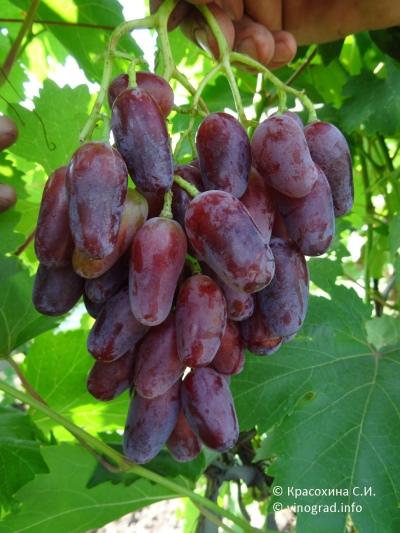
- Authors: Kapelyushny Vasily Ulyanovich
- Appointment: dining room
- Berry color: dark cherry
- Taste: nutmeg
- Ripening period: early
- Ripening period, days: 100-105
- Frost resistance, ° C: -25
- Name synonyms: II-5-7B
- Bunch weight, g: 700-1200
- Flower type: bisexual
Many gardeners would like to diversify their garden with a unique and rather exotic plant, but at the same time understandable for many. The Giovanni grape is exactly what many have been looking for. A unique and very interesting hybrid that attracts with its shape and color. You should find out the history of the breeding of this crop, its features, yield, as well as the nuances of cultivation.
Breeding history
This grape variety is a hybrid, that is, a crossed crop. Also called II-5-7B. The region of distribution is the southern part of Russia, and the culture can also be found on the territory of countries such as Ukraine, Moldova and Belarus.
This variety was bred by the gardener Kapelyushny V.U., a native of the Rostov region. He took 2 types of grapes as a basis for breeding a hybrid, namely: Red Delight and F-4.
Description
The Giovanni grape is a very interesting variety. This culture belongs to the early maturing. By the middle or end of July, the first berries appear, which can already be consumed.
The bush grows above average in size, so it is necessary to constantly look after the plant, preventing the shoots from growing too quickly. The bunches are rather large and weighty, the berries are large and dense. The leaves on the shoots are large, dark green in color.
Ripening period
The grapes are early maturing varieties, so flowering begins in May, until the fruits ripen, on average, it takes up to 120 days. If this crop is grown in the south, then after the buds swell, it takes 100-105 days for the first berries to ripen. If grown in the northern parts of the country, then the period may increase. Gardeners note that the degree of care and feeding of a given crop also affects the ripening period of berries.
Bunches
Each shoot grows 1 large bunch, you can rarely find a shoot on which 2 bunches have formed. The brushes are large in volume, weighing up to 1–1.2 kg. The average is the weight of 700 g.
The berries grow very tightly together. The stalks are strong, well connected to the vine, thanks to which a strong wind is not terrible for the harvest. The peculiarity of the bunches is that they can begin to turn into raisins, especially due to the fact that the crop was left to ripen for a long time.
Berries
The berries are quite large, varying in color from dark lilac, cherry (early fruits) to almost black with a lilac tint (later fruits). By weight, an average of 12 g, but with good feeding and favorable conditions, 1 berry can weigh up to 22 g. Length from 34 to 36 mm, diameter up to 26 mm. The form is finger-shaped or elongated nipple-shaped. The skin is smooth, medium in density, with a slight sheen. The pulp is fleshy, juicy, inside from 1 to 3 seeds.
Taste
Giovanni grapes have an exquisite, refined taste of sweetness with hints of nutmeg. Sugar content up to 20%, acidity does not exceed 7–8 g per 1 liter. The variety has an ideal ratio of sugar content and acidity, thanks to which this crop is often used both for food and for the production of wine.
Yield
Up to 15–20 kg are harvested from one bush, and up to 15–20 tons from one hectare. The yield is not affected by special weather conditions, the main thing is to observe disease prevention measures and feed the plant on time.


Growing features
This grape variety is very fond of a place that is lit by the sun. The soil should not be acidic, it is better if there are impurities of chernozem or clay in the ground. It is advisable not to be near water bodies.
It is better to plant seedlings in spring. In regions with hot climates, it can be planted in autumn.
Landing
Before planting, the seedlings should be soaked in water, and then remove excess shoots. The hole must be prepared with a size of 1X1 m. Between plantings, 3 m recede.Do not plant near trees, as well as fences or walls. Do the following:
- humus or manure must be poured into the hole, then a small layer of soft earth;
- then a seedling is planted;
- cover with earth and tamp;
- Spill generously with water, about 3 buckets per seedling.

Pollination
There is no need to do special pollination, the flowers are in grapes of both sexes.
Pruning
As the shoots grow, it is better to cut off the extra ones. Dry branches should also be removed. On average, pruning is done for 6-8 eyes, depending on the abundance. There are 35 eyes per bush.



Frost resistance and the need for shelter
Frost resistance reaches -24 °. But nevertheless, it is better to cover the plant with a film or covering material. Particular attention should be paid to young seedlings in the first 3 years.

Diseases and pests
Grapes should be treated with remedies for diseases and pests such as:
- mildew;
- phylloxera;
- gray rot;
It is also worth covering the bushes from birds with a special rigid mesh.

If a grape is exposed to any disease or insect, this always affects its appearance.
Storage
The bunches are cut off and placed in special boxes in 1–2 layers, between them layers of sawdust are poured 3 cm each. Storage temperature up to + 2 °. The room should be well ventilated, and the humidity should be no higher than 85%.











































































